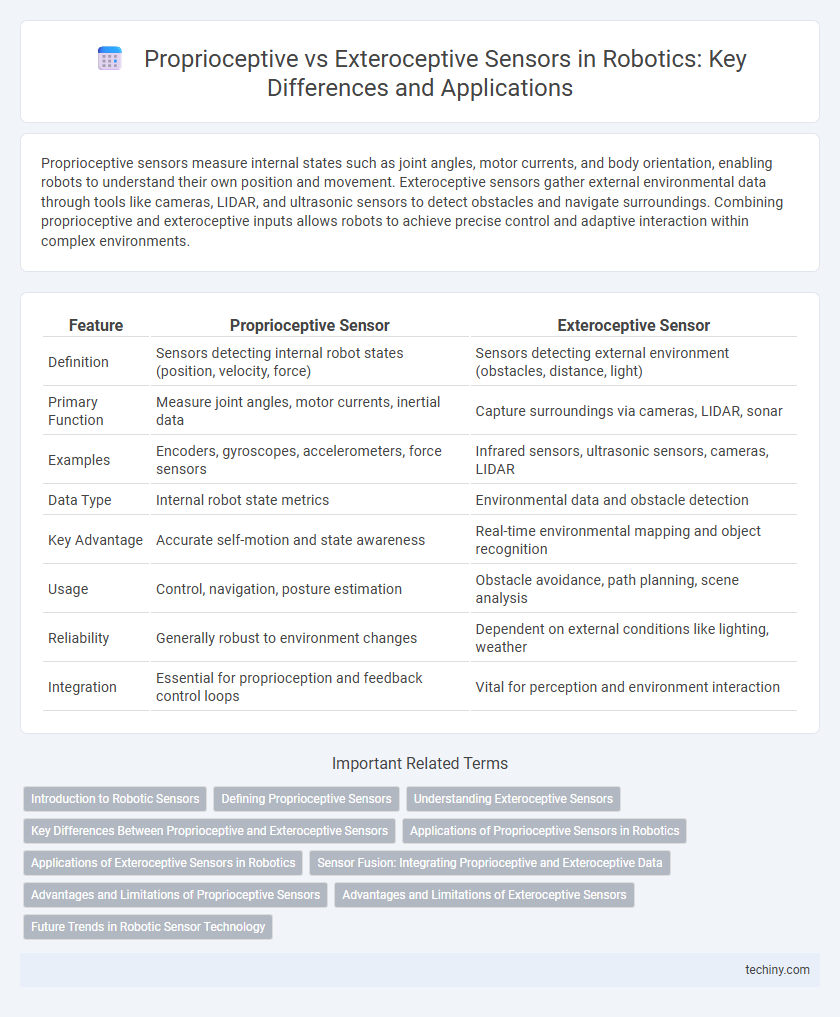Proprioceptive sensors measure internal states such as joint angles, motor currents, and body orientation, enabling robots to understand their own position and movement. Exteroceptive sensors gather external environmental data through tools like cameras, LIDAR, and ultrasonic sensors to detect obstacles and navigate surroundings. Combining proprioceptive and exteroceptive inputs allows robots to achieve precise control and adaptive interaction within complex environments.
Table of Comparison
| Feature | Proprioceptive Sensor | Exteroceptive Sensor |
|---|---|---|
| Definition | Sensors detecting internal robot states (position, velocity, force) | Sensors detecting external environment (obstacles, distance, light) |
| Primary Function | Measure joint angles, motor currents, inertial data | Capture surroundings via cameras, LIDAR, sonar |
| Examples | Encoders, gyroscopes, accelerometers, force sensors | Infrared sensors, ultrasonic sensors, cameras, LIDAR |
| Data Type | Internal robot state metrics | Environmental data and obstacle detection |
| Key Advantage | Accurate self-motion and state awareness | Real-time environmental mapping and object recognition |
| Usage | Control, navigation, posture estimation | Obstacle avoidance, path planning, scene analysis |
| Reliability | Generally robust to environment changes | Dependent on external conditions like lighting, weather |
| Integration | Essential for proprioception and feedback control loops | Vital for perception and environment interaction |
Introduction to Robotic Sensors
Proprioceptive sensors in robotics measure internal states such as joint angles, velocity, and force, providing critical feedback for motion control and balance. Exteroceptive sensors gather environmental data through modalities like vision, lidar, and ultrasonic sensing, enabling robots to perceive obstacles and navigate surroundings. Integrating proprioceptive and exteroceptive sensors optimizes robotic autonomy and precision in dynamic environments.
Defining Proprioceptive Sensors
Proprioceptive sensors in robotics measure internal states such as joint angles, torque, and motor currents, providing critical feedback for motion control and stability. These sensors include encoders, gyroscopes, and accelerometers that enable robots to sense their position and movement without external references. Their accurate internal data collection is essential for tasks requiring precise control and autonomous navigation.
Understanding Exteroceptive Sensors
Exteroceptive sensors play a critical role in robotics by enabling machines to perceive external environmental factors such as light, temperature, sound, and proximity. Common examples include cameras, LIDAR, ultrasonic sensors, and infrared sensors, which provide essential data for navigation, object detection, and environment mapping. These sensors complement proprioceptive sensors by expanding a robot's situational awareness beyond internal states to interact effectively with dynamic surroundings.
Key Differences Between Proprioceptive and Exteroceptive Sensors
Proprioceptive sensors measure internal states such as joint angles, motor currents, and body orientation, enabling robots to monitor their own movement and position. Exteroceptive sensors gather external environmental data like distance, temperature, and object recognition through devices such as LiDAR, cameras, and ultrasonic sensors. The key difference lies in proprioceptive sensors focusing on self-awareness for control and stability, while exteroceptive sensors provide situational awareness for navigation and interaction.
Applications of Proprioceptive Sensors in Robotics
Proprioceptive sensors in robotics measure internal states such as joint angles, motor currents, and actuator forces, enabling precise control of robot movement and posture. These sensors are essential for applications like robotic manipulators, where accurate feedback on limb position and force enhances manipulation tasks and stability. Proprioceptive data supports advanced functions in autonomous robots, including balance control in legged robots and force feedback in haptic devices.
Applications of Exteroceptive Sensors in Robotics
Exteroceptive sensors in robotics, such as LiDAR, cameras, and ultrasonic sensors, enable robots to perceive their external environment for navigation, obstacle detection, and object recognition. These sensors are critical in autonomous vehicles, robotic mapping, and human-robot interaction tasks by providing real-time data about surroundings. Enhanced situational awareness through exteroceptive sensing improves the robot's ability to operate safely and efficiently in dynamic and unstructured environments.
Sensor Fusion: Integrating Proprioceptive and Exteroceptive Data
Sensor fusion integrates proprioceptive data, such as joint angles and motor torques, with exteroceptive inputs like LiDAR and cameras to enhance robotic perception and control accuracy. Combining internal measurements with external environmental data enables robust state estimation, improving navigation and manipulation tasks in dynamic, complex environments. Advanced algorithms like Kalman filters and deep learning optimize the fusion process, reducing uncertainty and sensor noise for reliable real-time decision-making.
Advantages and Limitations of Proprioceptive Sensors
Proprioceptive sensors in robotics provide critical data on joint angles, motor currents, and internal forces, enabling precise control and feedback for accurate motion execution. Their advantage lies in high reliability and immunity to external environmental conditions, offering consistent performance in dynamic or obscured settings. However, proprioceptive sensors are limited by their inability to detect external obstacles or changes in the surrounding environment, requiring complementary exteroceptive sensors for comprehensive situational awareness.
Advantages and Limitations of Exteroceptive Sensors
Exteroceptive sensors in robotics, such as cameras and LiDAR, provide critical environmental data that enable precise navigation and object recognition, enhancing situational awareness. Their main advantage lies in detecting external stimuli without physical contact, facilitating complex interactions and real-time mapping. However, these sensors can be limited by environmental conditions like lighting, weather, and occlusions, which may degrade their accuracy and reliability in dynamic or cluttered settings.
Future Trends in Robotic Sensor Technology
Future trends in robotic sensor technology emphasize the integration of advanced proprioceptive sensors that monitor internal states such as joint angles, muscle tension, and actuator forces, enhancing robot self-awareness and precision. Exteroceptive sensors, including LiDAR, cameras, and tactile sensors, are evolving with improved resolution, speed, and environmental adaptability to enable robots to better perceive and interact with complex, dynamic surroundings. The convergence of multi-modal sensing architectures and AI-driven data fusion techniques promises to revolutionize sensor reliability and contextual understanding in next-generation robotic systems.
Proprioceptive sensor vs Exteroceptive sensor Infographic

 techiny.com
techiny.com